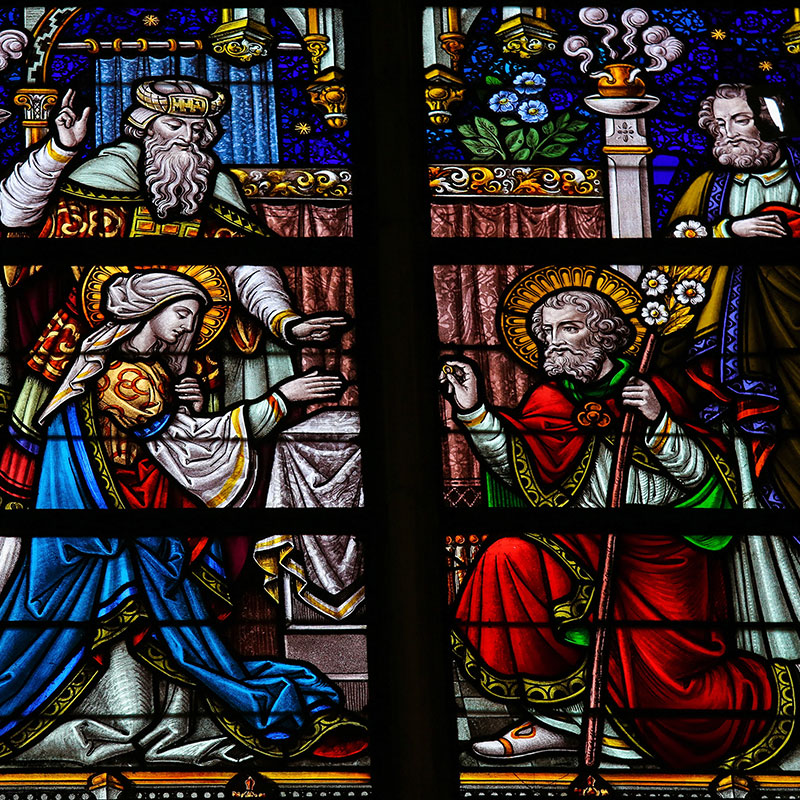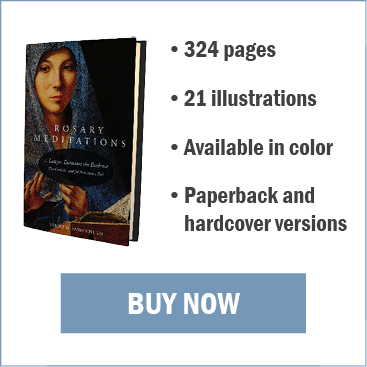
Saint Joseph
March 20 is the Solemnity of Saint Joseph, the Spouse of the Blessed Virgin Mary. On this holy day of obligation, we celebrate the man who played such an integral role in the early life of Jesus. While we do not have full knowledge of Joseph’s life—he disappears from the New Testament narrative when Jesus is twelve years old—we can gain an understanding of this man and his faith from what is presented in the Gospels.
Joseph’s Family
Joseph was of the house of David. While the genealogies given in Matthew and Luke vary greatly—that is, in Matthew, Joseph is the son of Jacob and in Luke he is the son of He’li1—Joseph’s remote descent from King David is established. Thus, as Joseph was considered Jesus’ legal father, Jesus fulfilled the Old Testament prophecy that the Messiah would rise from the Davidic line.
Joseph had at least one brother, Cleophas (also spelled Cleopas or Clopas). Cleophas was married to Mary, sometimes called the “sister” of the Virgin Mary. Mary was the widow of Alpheus, by whom she had the apostle James; Joses, who was sometimes referred to as Joseph Barsabbas; and Salome. Mary probably was widowed early and married Cleophas when the children were very young.
Joseph’s Age
Joseph is frequently portrayed as an old man at the time he married Mary. It is improbable that he was truly “aged,” as some portray him, since he was still vigorous enough to travel to Jerusalem for Passover twelve years later. Such portrayals represent an effort to bolster Mary’s continued virginity by creating a physical impediment, infirmity of age, to consummation of the marriage. We do not know his age, other than that he was no longer young. He took Mary to his own house, not his parents’ house, as a young man would have done.
Joseph’s Livelihood
Joseph lived in Nazareth, working as a carpenter. A village carpenter’s work included skilled cabinet-work, furniture, and house construction. Joseph was not rich, certainly not a “contractor,” as some have described him. When it came time to make the offering at Mary’s purification after Jesus’ birth, the offering was two doves, a less costly offering allowed for those who could not afford a lamb and a dove. Neither was Joseph at the bottom of the economic ladder, among those who sought—and occasionally found—labor by the day.
Joseph’s Dilemma
Joseph and Mary were betrothed, which in the eyes of the law of the time meant they were married. Just as the marriage would have been arranged by Mary’s mother, Anne, so too would Anne have served as the go-between to break the news to Joseph that Mary was with child. Anne told Joseph the entire story of the Visitation, assuring him that all the angel Gabriel had told Mary was true.
While Joseph could look to Elizabeth, who had just delivered John the Baptist, to see that Gabriel’s words held truth, imagine the weight that must have settled upon him. His betrothed was pregnant, not with his child, or even with another man’s child, but with the son of God. What made Joseph’s position even harder was when Anne told him that Mary was married to the Lord; in a marriage between Joseph and Mary, he would have to forego conjugal relations.
This was a hard future for Joseph to accept. In fact, all Anne had told him was hard to believe. The ordinary Jew did not know the details of the Messianic prophecies—that he would be born in Bethlehem to a virgin of the Davidic line. This was a subject for the rabbis and priests. Joseph likely asked the rabbi oblique questions to be sure of Anne’s tale of what scripture foretold about the Messiah’s origins. So, in addition to his doubt as to the child’s paternity, the requirement of birth in Bethlehem cast further question on Anne’s tale. Joseph eventually decided “to divorce her quietly.”
Joseph’s First Dream
The Gospels tell us that Joseph had four dreams in which he was visited by angels of the Lord. The first occurred after he had made the decision to divorce. An angel of the Lord appeared to him in a dream, “…saying, ‘Joseph, son of David, do not fear to take Mary your wife, for that which is conceived in her is of the Holy Spirit; she will bear a son, and you will call his name Jesus, for he will save his people from their sins….’ When Joseph woke, he did as the angel of the Lord commanded him; he took his wife, but knew her not until she had borne a son; and he called his name Jesus.”
Having heard from Anne the descriptions of an angel’s appearance to Mary and to Zechariah, Joseph had no difficulty recognizing an angel in his dream. We do not know whether the angel was Gabriel or another. Likewise, having heard Anne’s story of the communications of the angel to Mary and to Zechariah, and how one of them believed and the other did not, Joseph’s heart had already been softened and his mind prepared to accept the truth. When he awoke, he believed the angel’s message to him and, therefore, what Anne had told him.
Sometime after Mary moved in with Joseph, a Roman order for a census was received in Nazareth. Every man had to report to his tribal “home” for the census. As a member of the house of David, Joseph was required to travel to Bethlehem, the city of David. The missing piece in Scripture’s description of the Messiah, that he would be born in Bethlehem of a virgin of the house of David, had been supplied. All those privy to the secret—Mary, Anne, Zechariah, Elizabeth, and Joseph—had wondered how Mary was carrying the Messiah although she lived in Nazareth. Suddenly the Scripture was fulfilled. They were overjoyed, especially Joseph, since his faith had thereby been confirmed.
Joseph’s Second Dream
After Jesus’ birth, the Magi told Joseph and Mary that Herod had told them to return to him and disclose the Messiah’s location, and that they had been warned in a dream not to do so. In addition to Herod’s knowledge of the Magi’s mission, Joseph was concerned by the gossip in Bethlehem since the shepherds’ visit and by Anna’s public proclamation of the Messiah’s birth and presentation. Soon after falling asleep, “an angel of the Lord appeared to Joseph in a dream and said, ‘Rise, take the child and his mother, and flee to Egypt, and remain there till I tell you; for Herod is about to search for the child, to destroy him.’ And he rose and took the child and his mother by night, and departed to Egypt, and remained there until the death of Herod.”
We do not know in what part of Egypt the Holy Family spent their exile. Joseph’s skill as a carpenter was a portable trade, and he could make a living at it anywhere there was work. The gifts of the Magi provided the capital to finance the travel and re-establishment of the family. Doubtless, Cleophas protected Joseph’s property in Nazareth.
Joseph’s Third and Fourth Dreams
When Herod died, an angel of the Lord appeared in a dream to Joseph, saying, ‘Rise, take the child and his mother, and go to the land of Israel, for those who sought the child’s life are dead.’ The Holy Family left Egypt. If Joseph led his family toward Palestine during the fall, they could have arrived after news of the division of Herod’s kingdom and the allotments to his three sons. As they returned along the Way of the Sea to Israel, when they arrived in Ascalon, peaceful under Roman rule, they learned that large areas of Israel had erupted in civil war and brigandage. This period of turmoil went on for up to two years following Herod’s death. By that time Archelaus’ brutality was obvious to all. The safest way through Archelaus’ kingdom was the well-traveled highway through Caesarea, thence into Phoenicia.
Again, prompted by a dream, Joseph waited in a safe place, probably Tyre in southern Phoenicia. The territory around the capital of Galilee, Sepphoris, would have been pacified sooner than the remoter areas. It is likely that the reference in Revelation to the woman fleeing into the wilderness for three and a half years is to the period of Mary’s and Joseph’s exile. The earliest date for the Holy Family’s safe return to Nazareth was in late summer or fall of 3 BC, when Jesus was three-and-a-half years old—a date which probably, not coincidentally, is the same as the three-and-a-half years in Revelation.
Joseph’s Last Appearance
Joseph does not appear in the Gospels again until the story of the young Jesus in the temple. Joseph, Mary, and Jesus went to Jerusalem for Passover every year, traveling with the annual Nazareth caravan. Jesus had turned twelve that year and was to be catechized and confirmed. When the Nazareth caravan left Jerusalem, Jesus stayed behind to focus on learning the current teachings of Judaism.
There is a tradition that Joseph and Mary discovered Jesus’ absence at the caravanserai at Bireh, about twenty miles north of Jerusalem. By the time they arrived in Jerusalem to search for Jesus, the gates to the temple were closed. The next morning (“the third day”) they found him in the temple in one of the groups of students and disciples gathered around a teacher. This episode marks the last we hear of Joseph; by the time of Jesus’ ministry, he has apparently died.
As we celebrate Saint Joseph next Monday, we remember the man whose kindness, faith, and devotion to family helped to ensure that our salvation would be realized through the one he called his son, Jesus.
